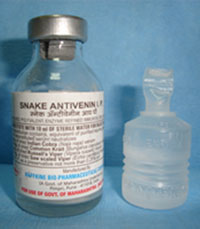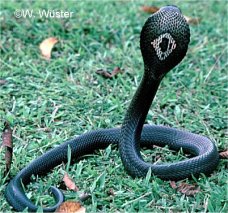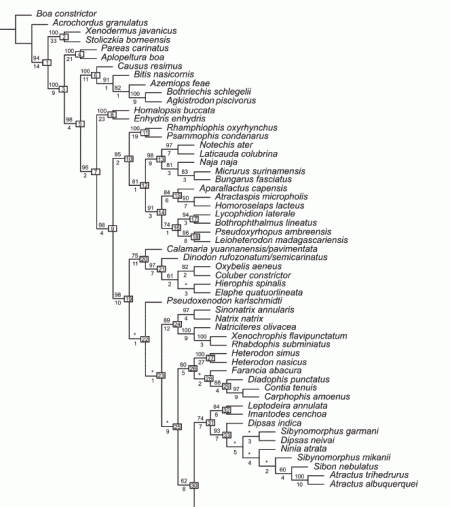In any nature outing, you will find at least one guy who decides that the hapless snake, accidentally discovered, is meant solely for showing off his courage, daring and virility. The poor snake is purloined, handled, twisted, turned into a garland and poked forward towards shrieking members of the fairer sex. No thought is given to the fact that the snake needs to held correctly without damaging its fragile bones.

Image Credit : Thomas Kelly. Copyrighted. Click image for link url. (Under Fair Use).
Another characteristic of such encounters is the lamentable lack of proper knowledge by these “heroes”, who consequently endanger their own and their friends’ lives.
Besides juvenile immaturity, another reason for such acts is the emulation of the profusion of snake wrangler shows on TV! While they appear to popularise these creatures, many so-called snake experts mis-handle these snakes for the sake of “better cinema”.

Wrong lesson! A famous TV snake wrangler with a Black Mamba - never ever try this at all!
More importantly, the wranglers do very dangerous things and make it look safe and easy. You would not feel so impressed by some one who took great care in handling and cautioned you of the many dangers. The truth is that they are experts in handling snakes but it is very dangerous and foolish to emulate them in any manner.
Anyone truly interested in snakes is careful and considerate while handling these elegant creatures. Handling of snakes is to be avoided in general, and if necessary, is to be done for the right reasons such as rescuing them, for educating people, for captive breeding or conservation. It is never meant to be done to enhance one’s own reputation.
Here is an interesting photograph – an acquaintance of mine is touching what he thought is a “Python“. Except, that its an extremely lethal Russell’s Viper.
The officer is innocent – he was told by a nature-loving friend that it was indeed a python. Apparently, his nature-loving friend who helped him overcome his fears of touching snakes was just as knowledgeable as he was. Amazingly, both had handled the “python” and had not been bitten. God protects the innocent sometimes.

Full marks to this officer for daring to touch a "python". Fortunately, he doesn't know its a Russel's Viper and the snake did not bite.
A villager had brought them an “
ajgar” (Hindi or Marathi for python) and they had foolishly believed in his store of native knowledge and his skills of identification. Fortunately, the handsome Russel’s Viper belied the evil eye and cold sneer of his face and acted like a perfect gentle-python! It could so easily have been a more dramatic story.
These young men were basically photography buffs and interested, but inexperienced, in Nature. This incident is a caution to all photographers of nature – be a naturalist first then a photographer. You will be a much better photographer if you understand your elusive subjects. More importantly, you will not put yourself in such dangerous spots.
One should be highly circumspect about handling snakes. In India, we have a number of venomous snakes, some not only deadly to humans but also fairly common.
The “Big Four” venomous snakes in India are the Indian Cobra, the Common Krait, the Russell’s Viper and the Saw-scaled Viper.

The binocellate Indian Cobra (Naja naja)

Russel's Viper (Daboia russelii)

Common Krait (Bungarus caeruleus)

Saw-scaled Viper (Echis carinatus)
The Big Four snakes are responsible for more than 90% of venomous snake-bite deaths in our country. The Hafkinne Institute makes a polyvalent anti-venin which is effective in treating bites by the big four snakes. This anti-venin is freely available in Govt dispensaries and has saved the lives of many of our countrymen.

Polyvalent anti-snake venom serum from Haffkine. (Click image for more information)
But there is no guarantee that this antivenin being available – makes the handling of snakes safe. If you are bitten in the wild, you could succumb before reaching medical aid. You could reach in time but not respond to the treatment or even be allergic to one of the active ingredients of the anti-venin. Alternatively, the Primary Health Centre may be out of vaccine. Keeping India’s rural electricity in mind, the antivenin may be ineffective due to its not being stored at the right temperatures.
Earlier we used to be worried only about the “Big Four” – the four highly venomous snakes in the Indian country-side considered to be responsible for the majority of deaths due to snake-bite . But there are many others too, such as the King Cobra, the Banded Krait, Hump-nosed Pit Viper, the many green pit vipers (Trimeresurus complex) and many other vipers, the Rhabdobis group of poisonous colubrid snakes.

Sir Joseph Fayrer's 1874 illustration of a King Cobra

Banded Krait (Bungarus fasciatus) photgraphed by me in Binnaguri, North Bengal.

Hump-nosed Viper (Hypnale hypnale). (Image credit : Vijay Barve)
All these are venomous snakes of great medical importance, more so as no anti-venin is available in India for treating their bites. They are usually uncommon, some are found in deep forest, inaccessible places, or are rare or even extremely docile (sea-snakes). Naturalists would do well to remember that the Polyvalent serum is useless in treating the bites of these snakes.
As far as anti-venin is concerned, there is an added complication. Recent taxonomic studies using genome mapping have revealed that the Big Four snakes in India (except the Russel’s Viper) are not one species but actually comprise more than one species.
The
Saw-scaled Viper in the Deccan plateau is
Echis carinatus while the saw-scaled viper found in Rajasthan and North-west India is
Sochurek’s Viper Echis sochureki (earlier a subspecies of
Echis carinatus) .
The
Common Cobra (
Naja naja) has now been hived off into many species (see Wuster for an interesting account of Asian cobras). A total of four different cobras are found in India -
- The binocellate Indian Cobra Naja naja,
- The Monocellate Cobra Naja kaouthia,
- The Central Asian Cobra Naja oxiana,
- The Andaman Cobra Naja sagittifera,
- There is a possibility that the Burmese Spitting Cobra Naja mandaleyensis is also found in the general area of Manipur – Mizoram.
Wall’s Krait (
Bungarus sindianus), a subspecies of the
Common Krait (
Bungarus caeruleus) that is found in North West India and is known to extend down to Pune, has now been given separate species status.

Monocled Cobra (Naja kaouthia) (Image: W. Wuster - Click image to reach source).

Wall's Krait (Bungarus sindanus) (Image : Tom Charlton - click link to reach source)

Sochurek's Viper (Image:Tomáš Mazuch, click to reach source)
So why should we bother that these snake species have been split?
Earlier, snakes were classified into species or types, by comparing physical characteristics such as shape, number and position of scales and on the shape of their bones, besides other things. While this helps us to classify them broadly, the fine graining or distinguishing between what constitutes a species or not was a subjective opinion of experts based on these morphological characteristics.

A typical snake scale image used in morphological taxonomy (from Wikipedia) .
Genome studies map individual DNA sequences, genes and chromosomes. Since all life has originated once and the entire biodiversity of extinct and extant animals have evolved from the first forms of life created in evolution, the DNA of a species bears evidence of its evolution through the years. Through difficult science and advanced computational mathematics using very powerful computers, genome scientists have developed techniques of ascertaining the phylogeny of creatures. These studies help differentiate species from the differences in genes rather than from morphology alone. This permits us to classify and relate different species with much more accuracy and reliability.

Part of a snake phyllogeny diagram deduced through genomic investigations. (Click the image to reach the source paper and learn more.)
Click to enlarge : part image or for the full image of phylogeny.
If the Cobra has now been classified as many different cobra species – it means that these were many different snakes to begin with. Not one common, found all over Asia cobra as we thought. That means each species of cobra found in Indian territory has its own set of characteristics including a different venom composition for which the anti-venin needs to be made separately. When we thought that these cobras were subspecies of the old Common Cobra (Naja naja) , we thought that basically their venom composition was similar – i.e. basically same but with small differences. Now we find that though they may resemble each other their venom could be very different. Just taking a binocellate cobra and making its antivenin, hoping it will work for the other three cobra species, will no longer do.
A recent study on Snakebite Management in Asia & Africa – A guide to snakebite in the key areas for mortality & morbidity by the Pakistan Medical Research Council clearly indicates that
Naja oxiana and
Naja kaouthia are not covered by availability of anti-snake-venom, i.e. the Haffkine Polyvalent Snake Venom is only good for
Naja naja.
It appears from this website of the Haffkine Bio-pharmaceutical Corporation that polyvalent venom is being made for the old Big Four. No mention is made of the finer detail revealed by latest taxonomic advances.
So don’t have blind faith that “
since anti-venin exists, I can risk a snake-bite“.
The entry and interaction of such terrible poisons as those contained in snake venom wreaks terrible damage even if life is saved by prompt treatment. Neelimkumar Khaire, a celebrated snake-handler of Pune, lost his arm to a saw-scaled viper bite. Romulus Whitaker, it is said, can no longer catch snakes because he has been bitten so many times, the next bite or its treatment will kill him! Bites from snakes having active haemolytic ingredients in their venom can cause loss of kidneys. Each snake-bite would involve necrosis, organ damage and many other horrible side effects. What kind of a life will that be – a cripple, an invalid, a dialysis patient – and all for the sake of an ego or carelessness or incompetence or all three?
If you still want to become a snake handler, first please see the destructive power of snake bites here :
- “Snake-bite” on Wikipedia.
- The management of snake-bites in Malaysia.
- Monocled cobra bites.
And remember, these were those who LIVED!
Understand that this is a very dangerous business and then and then alone get involved with it.
If you or an acquaintance is bitten by a snake, what should be done?
First of all do not neglect it, even if you think or know the snake is non-poisonous, even if the skin does not appear to be broken. Don’t even consider the old tourniquet thing, cut and suck, ice-therapy, the PIM method or “Jadi-buti” treatment. Get to medical aid as soon as possible.
While moving a snake-bite casualty to hospital, do it RIGHT by following the the latest national first aid treatment recommended – based around the mnemonic : “Do it R.I.G.H.T.” : -
It consists of :
R. = Reassure the patient. Seventy per cent of all snakebites are from non-venomous species. Only 50% of bites by venomous species actually envenomate the patient.
I. = Immobilise the bitten limb in the same way as a with fractured limb. Use bandages or cloth to hold the splints, not to block the blood supply or apply pressure. Do not apply any kind of compression in the form of tight ligatures, they don’t work and can be dangerous!
G.H. = Get the patient to Hospital immediately. Traditional remedies have NO PROVEN benefit in treating snakebite.
T. = Tell the doctor of any systemic symptoms such as ptosis that manifest on the way to hospital.
To read more :
- Indian National Snakebite Protocol 2007.
- Guidelines for the Clinical Management of Snake Bite in the South-East Asia Region. (Gives details of this protocol from WHO)
- Snakebite Management in Asia & Africa – A guide to snakebite in the key areas for mortality & morbidity.
None of this is meant to discourage you dear reader from being interested in snakes – we want all Indians to be educated about snakes.
If you are interested in snakes – that’s great! Watch Animal Planet, Discovery and National Geographic channels on TV. Get a good book, learn about them, their habits, identifying the species and their wonderful way of life. If you would like to learn how to handle snakes, go to snake-parks where carefully supervised handling may be permitted. Get to know snake rescuers and accompany them to snake rescues.

Safe handling of a harmless snake - a Common Trinket - for education of the lay public.
Most important of all – be a “
sarpamitra” i.e. a friend of snakes. Fight blind belief and educate your family, friends and neighbours that snakes do not drink milk or have jewels embedded in their heads. They do not have photography in their retinas that they retain after death and transmit to their mates who then search that person out for revenge in the best Bollywood tradition. Prevent the blind killing of snakes, help them escape to safety.
Snakes are dangerous creatures but not so much to the common Indian who fears snakes but more so to those who choose to handle them with inadequate knowledge and experience. It would be wise to heed the words of Dr. Ian D. Simpson of the W.H.O. Snakebite Treatment Group who is one of the prominent snake-bite treatment experts of South Asia :-

 We pray to him for our protection from all wilderness around. Hindus believe that our souls take several times birth on this earth or we can say re-incarnated several times unless and until we are all truthfully perform our worldly duties and our soul becomes as pure as the holy water of the river Ganga, then only we can leave this physical world forever to meet in heaven our God almighty. So, in this whole process, the first life we get in this world is in the form of snakes and after that a human life and then it goes on. But,the life in the form of human is the precious of all. So, it is obvious that we don`t want to get in the circulation of re-birth again and for that we pray to God to take our souls after death to heaven and promises that the beautiful human life he had given to us will be away from all sins. But,this human life is so hypnotic that our souls got entangled in the worst only in this precious span of life.
We pray to him for our protection from all wilderness around. Hindus believe that our souls take several times birth on this earth or we can say re-incarnated several times unless and until we are all truthfully perform our worldly duties and our soul becomes as pure as the holy water of the river Ganga, then only we can leave this physical world forever to meet in heaven our God almighty. So, in this whole process, the first life we get in this world is in the form of snakes and after that a human life and then it goes on. But,the life in the form of human is the precious of all. So, it is obvious that we don`t want to get in the circulation of re-birth again and for that we pray to God to take our souls after death to heaven and promises that the beautiful human life he had given to us will be away from all sins. But,this human life is so hypnotic that our souls got entangled in the worst only in this precious span of life.











































